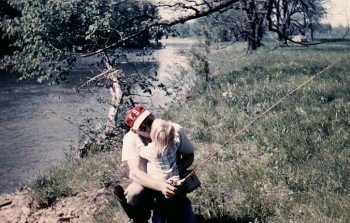| Valerie and John at Forked Creek, 1960 |

|
| Valerie and John at Forked Creek, 1960 |

|
Most creeks and rivers in Illinois are fairly muddy, but Forked Creek was always clear, no matter what the water level. In summer, there were still, deep, green holes for fishing and swimming, but also many shallow places where the water rippled over gravel. The banks were grassy and fallen logs a smooth silver-gray; and there were huge shade trees whose leaves chattered in the wind. I used to use a little dip-net and catch water creatures to put in a jar. The most unusual animals were the horsehair worms. I would find them in clusters under the banks, wound in knots around tree roots. They really did look like hair and were an iridescent brown color. I found them fascinating to watch as they slowly twisted and writhed.
 Some added information about horsehair worms: These animals are often found in livestock tanks and small streams, leading to the myth that they are actually horse hairs that have come alive. Another name for them is Gordian worms, after the mythical knot. Adult horsehair worms have non-functional digestive systems and their sole purpose is to mate and produce eggs. The young first live as parasites in aquatic creatures such as crustaceans and mollusks, then continue their development inside grasshoppers, crickets, and other terrestrial arthropods. They usually manage to get back to the water when their host insect falls in and drowns.
Some added information about horsehair worms: These animals are often found in livestock tanks and small streams, leading to the myth that they are actually horse hairs that have come alive. Another name for them is Gordian worms, after the mythical knot. Adult horsehair worms have non-functional digestive systems and their sole purpose is to mate and produce eggs. The young first live as parasites in aquatic creatures such as crustaceans and mollusks, then continue their development inside grasshoppers, crickets, and other terrestrial arthropods. They usually manage to get back to the water when their host insect falls in and drowns.